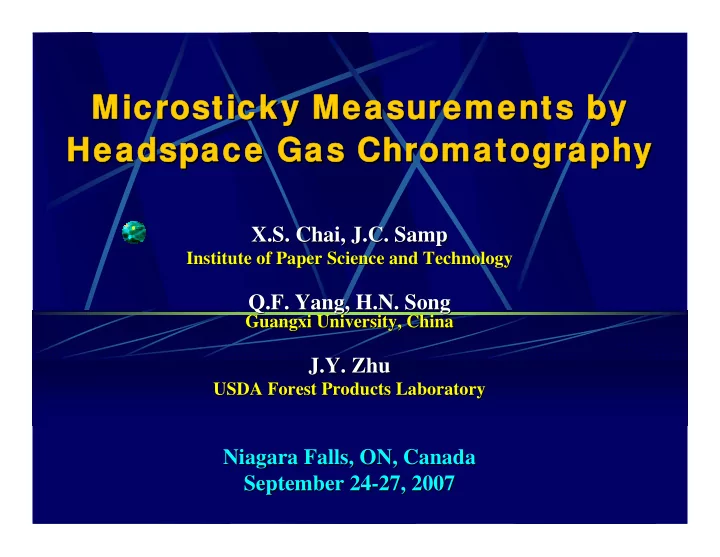

Microsticky Microsticky Measurements by Measurements by Measurements by Microsticky Microsticky Measurements by Headspace Gas Chromatography Headspace Gas Chromatography Headspace Gas Chromatography Headspace Gas Chromatography X.S. Chai, J.C. Samp X.S. Chai, J.C. Samp Institute of Paper Science and Technology Institute of Paper Science and Technology Q.F. Yang, H.N. Song Q.F. Yang, H.N. Song Guangxi University, China Guangxi University, China J.Y. Zhu J.Y. Zhu USDA Forest Products Laboratory USDA Forest Products Laboratory Niagara Falls, ON, Canada Niagara Falls, ON, Canada September 24- -27, 2007 27, 2007 September 24
BACKGROUND Stickies and and Microstickies Microstickies Stickies Pass through 0.006” ” slots slots Pass through 0.006 TOC method: filtrate through 3,000- -10,000 10,000 TOC method: filtrate through 3,000 Dalton cut- -off membrane off membrane Dalton cut Dissolved and colloidal form Dissolved and colloidal form
BACKGROUND - Headspace Gas Chromatography (HSGC) Headspace Gas Chromatography (HSGC) Headspace Gas Chromatography (HSGC) Headspace Gas Chromatography (HSGC) Sample Vial Headspace (Vapor) Sample
HS GAS CHROMATOGRAPHY - Vapor- -Liquid Equilibrium Analysis Liquid Equilibrium Analysis Vapor Solute Headspace Vaporized Solute Sample Sample Water (Solvent)
PHYSICAL MODEL Solute Water Adhesive
HSGC: MICROSTIKIES HSGC: MICROSTIKIES MEASUREMENTS MEASUREMENTS Toluene GC Signal Vaporized Solute Water Water Toluene Toluene 0 0 Adhesives + Adhesives + Adhesives
MATHEMATICAL MODEL S apparent effective surface area apparent effective surface area S = − 0 / C K C k S k 1 1 adsorptivity adsorptivity of the solute on of the solute on k g l 1 the polymer substances the polymer substances k hydrophobic characterization coefficient k hydrophobic characterization coefficient m = s of the polymers S k of the polymers ρ ⋅ ρ density of sticky material d density of sticky material d average diameter of average diameter of microsticky microsticky particles particles d = − ⋅ = − ⋅ m a b ' C a b A s g
EXPERIMENTAL Four Commercial Adhesives Four Commercial Adhesives Carbtac Carbtac Avery acrylic Avery acrylic HYCAR 26288 HYCAR 26288 Unknown PSA Unknown PSA Key Chemical Composition Key Chemical Composition Polyacrylates ( (e.g., e.g., PMMA) and Co PMMA) and Co- -polymer polymer Polyacrylates μ m Solution: 0.7 μ Particle Size in 50 ppm ppm Solution: 0.7 m Particle Size in 50
EXPERIMENTAL HS GC Conditions HS GC Conditions Flame ionization detector (FID) Flame ionization detector (FID) 30 m Capillary Column (HP- -5) 5) 30 m Capillary Column (HP Headspace with in- -house made compressed air house made compressed air Headspace with in cooling conduit: to temperature 32 o o C C cooling conduit: to temperature 32 Sample Sample μ L ) 10 μ 85 ppm ppm ( (v/v v/v) 10 L toluene toluene- -methanol methanol added to added to 85 5 mL mL sample in a 20 sample in a 20 mL mL vial ( vial ( toluene= toluene=170 ppb) 170 ppb) 5
WITHOUT A HEADSPACE SYSTEM? 5 mL sample 10 mL Toluene-methanol
EQUILIBRIUM OF THREE PHASE SYSTEM 140 o C Temp. = 32 120 PSA = 1000 ppm 100 GC signal 80 60 40 20 0 0 2 4 6 8 10 12 14 16 Equilbration time, min.
PHYSICAL MODEL Surface effect – – Surface effect Surface area or Surface area or particle size particle size Adhesive type Temperature Adhesive Solute/Adhesive content
PRELIMINARY RESULTS o C 60 1.0 Normalized GC signal 0.9 o C 32 Toluene content 0.8 170 ppb 400 ppb 170 ppb 0.7 0 200 400 600 800 1000 Polyacrylate added, ppm
Matrix Effect Fine Clay Starch NaCl Content Content GC Content Content GC GC GC (ppm) (ppm) signal (ppm) mol/L signal signal signal 0 99.9 0 100.4 0 100.8 0 100.8 200 100.1 40 99.0 200 100.4 0.02 100.4 400 99.9 80 100.9 400 99.5 0.04 99.5 600 98.9 120 100.7 600 101.0 0.06 101 800 99.7 200 101.4 800 100.6 0.08 100.6 1,000 98.3 300 99.6 1,000 101.4 0.1 101.4
CALIBRATION − − = ± − × ± × 4 6 A 0 . 996 ( 0 . 005 ) 1 . 686 10 ( 8 . 4 10 ) m s 1.00 2 = 0.9926 Normalized GC signal R 0.95 0.90 0.85 o C, 10 min T = 32 Carbtac 0.80 PSA Avery acrylic 0.75 HYCAR 26288 0.70 0 200 400 600 800 1000 Amount of microstickies, ppm
1000 Standard added (ppm) 800 VALIDATION y = 0.942x, r = 0.989 600 400 Data 200 0 1000 800 600 400 200 0 HSGC Measured (ppm)
SUMMARY Demonstrated a HSGC technique for the Demonstrated a HSGC technique for the determination of the amount of microstickies microstickies determination of the amount of in white water. in white water. Toluene is an effective agent that can sense e Toluene is an effective agent that can sens the change of the amount of microstickies microstickies in in the change of the amount of white water. white water. o C seems effective Headspace temperature 32 o C seems effective Headspace temperature 32 for the technique. for the technique. For the limited studies conducted, the four For the limited studies conducted, the four adhesives have similar behavior for HSGC adhesives have similar behavior for HSGC measurements. measurements.
SUMMARY The effect of the particle size of microstickies microstickies The effect of the particle size of needs to be studied in the future. needs to be studied in the future.
Recommend
More recommend